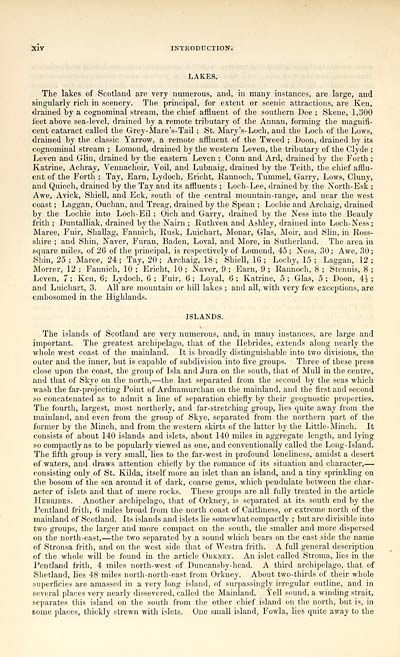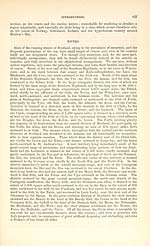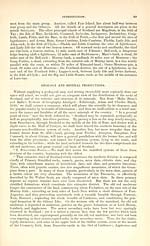Download files
Complete book:
Individual page:
Thumbnail gallery: Grid view | List view

XIV INTRODUCTION.
LAKES.
The lakes of Scotland are very numerous, and, in many instances, are large, and
singularly rich in scenery. The principal, for extent or scenic attractions, are Ken,
drained by a cognominal stream, the chief affluent of the southern Dee ; Skene, 1,300
feet above sea-level, drained by a remote tributary of the Annan, forming the magnifi-
cent cataract called the Grey-Mare 's-Tail ; St. Mary's- Loch, and the Loch of the Lows,
drained by the classic Yarrow, a remote affluent of the Tweed ; Doon, drained by its
cognominal stream ; Lomond, drained by the western Leven, the tributary of the Clyde ;
Leven and G-lin, drained by the eastern Leven ; Conn and Ard, drained by the Forth ;
Katrine, Achray, Vennachoir, Voil, and Lubnaig, drained by the Teith, the chief afflu-
ent of the Forth ; Tay, Earn, Lydoch, Ericht, Rannoch, Tummel, Garry, Lows, Cluny,
and Quiech, drained by the Tay and its affluents ; Loch-Lee, drained by the North-Esk ;
Awe, Avick, Shiell, and Eck, south of the central mountain-range, and near the west
coast ; Laggan, Ouchan, and Treag, drained by the Spean ; Lochie and Archaig, drained
by the Lochie into Loch-Eil ; Oich and Garry, drained by the Ness into the Beauly
frith ; Duntalliak, drained by the Nairn ; Ruthven and Ashley, drained into Loch-Ness;
Maree, Fuir, Shallag, Fannich, Rusk, Luichart, Monar, Glas, Moir, and Slin, in Ross-
shire ; and Shin, Naver, Furan, Baden, Loval, and More, in Sutherland. The area in
square miles, of 26 of the principal, is respectively of Lomond, 45 ; Ness, 30 ; Awe, 30
Shin, 25 ; Maree, 24 ; Tay, 20 ; Archaig, 18 ; Shiell, 1G ; Lochy, 15 ; Laggan, 12
Morrer, 12 ; Fannich, 10 ; Ericht, 10 ; Naver, 9 ; Earn, 9 ; Rannoch, 8 ; Stennis, 8
Leven, 7 ; Ken, 6; Lydoch, 6 ; Fuir, 6 ; Loyal, 6 ; Katrine, 5 ; Glas, 5 ; Doon, 4i
and Luichart, 3. All are mountain or hill lakes ; and all, with very few exceptions, are
embosomed in the Highlands.
ISLANDS.
The islands of Scotland are very numerous, and, in many instances, are large and
important. The greatest archipelago, that of the Hebrides, extends along nearly the
whole west coast of the mainland. It is broadly distinguishable into two divisions, the
outer and the inner, but is capable of subdivision into live groups. Three of these press
close upon the coast, the group of Isla and Jura on the south, that of Mull in the centre,
and that of Skye on the north, — the last separated from the second by the seas which
wash the far-projecting Point of Ardnamurchan on the mainland, and the first and second
so concatenated as to admit a line of separation chiefly by their geognostic properties.
The fourth, largest, most northerly, and far-stretching group, lies quite away from the
mainland, and even from the group of Skye, separated from the northern part of the
former by the Minch, and from the western skirts of the latter by the Little-Minch. It
consists of about 140 islands and islets, about 140 miles in aggregate length, and lying
so compactly as to be popularly viewed as one, and conventionally called the Long- Island.
The fifth group is very small, lies to the far-west in profound loneliness, amidst a desert
of waters, and draws attention chiefly by the romance of its situation and character, —
consisting only of St. Kilda, itself more an islet than an island, and a tiny sprinkling on
the bosom of the sea around it of dark, coarse gems, which pendulate between the char-
acter of islets and that of mere rocks. These groups are all fully treated in the article
Hebrides. Another archipelago, that of Orkney, is separated at its south end by the
Pentland frith, G miles broad from the north coast of Caithness, or extreme north of the
mainland of Scotland. Its islands and islets lie somewhat compactly ; but are divisible into
two groups, the larger and more compact on the south, the smaller and more dispersed
on the north-east, — the two separated by a sound which bears on the east side the name
of Stronsa frith, and on the west side that of Westra frith. A full general description
of the whole will be found in the article Okkney. An islet called Stroma, lies in the
Pentland frith, 4 miles north-west of Duncansby-head. A third archipelago, that of
Shetland, lies 48 miles north-north-east from Orkney. About two-thirds of their whole
superficies are amassed in a very long island, of surpassingly irregular outline, and in
several places very nearly dissevered, called the Mainland. Yell sound, a winding strait,
separates this island on the south from the other chief island on the north, but is, in
some places, thickly strewn with islets. One small island, Fowla, lies quite away to the
LAKES.
The lakes of Scotland are very numerous, and, in many instances, are large, and
singularly rich in scenery. The principal, for extent or scenic attractions, are Ken,
drained by a cognominal stream, the chief affluent of the southern Dee ; Skene, 1,300
feet above sea-level, drained by a remote tributary of the Annan, forming the magnifi-
cent cataract called the Grey-Mare 's-Tail ; St. Mary's- Loch, and the Loch of the Lows,
drained by the classic Yarrow, a remote affluent of the Tweed ; Doon, drained by its
cognominal stream ; Lomond, drained by the western Leven, the tributary of the Clyde ;
Leven and G-lin, drained by the eastern Leven ; Conn and Ard, drained by the Forth ;
Katrine, Achray, Vennachoir, Voil, and Lubnaig, drained by the Teith, the chief afflu-
ent of the Forth ; Tay, Earn, Lydoch, Ericht, Rannoch, Tummel, Garry, Lows, Cluny,
and Quiech, drained by the Tay and its affluents ; Loch-Lee, drained by the North-Esk ;
Awe, Avick, Shiell, and Eck, south of the central mountain-range, and near the west
coast ; Laggan, Ouchan, and Treag, drained by the Spean ; Lochie and Archaig, drained
by the Lochie into Loch-Eil ; Oich and Garry, drained by the Ness into the Beauly
frith ; Duntalliak, drained by the Nairn ; Ruthven and Ashley, drained into Loch-Ness;
Maree, Fuir, Shallag, Fannich, Rusk, Luichart, Monar, Glas, Moir, and Slin, in Ross-
shire ; and Shin, Naver, Furan, Baden, Loval, and More, in Sutherland. The area in
square miles, of 26 of the principal, is respectively of Lomond, 45 ; Ness, 30 ; Awe, 30
Shin, 25 ; Maree, 24 ; Tay, 20 ; Archaig, 18 ; Shiell, 1G ; Lochy, 15 ; Laggan, 12
Morrer, 12 ; Fannich, 10 ; Ericht, 10 ; Naver, 9 ; Earn, 9 ; Rannoch, 8 ; Stennis, 8
Leven, 7 ; Ken, 6; Lydoch, 6 ; Fuir, 6 ; Loyal, 6 ; Katrine, 5 ; Glas, 5 ; Doon, 4i
and Luichart, 3. All are mountain or hill lakes ; and all, with very few exceptions, are
embosomed in the Highlands.
ISLANDS.
The islands of Scotland are very numerous, and, in many instances, are large and
important. The greatest archipelago, that of the Hebrides, extends along nearly the
whole west coast of the mainland. It is broadly distinguishable into two divisions, the
outer and the inner, but is capable of subdivision into live groups. Three of these press
close upon the coast, the group of Isla and Jura on the south, that of Mull in the centre,
and that of Skye on the north, — the last separated from the second by the seas which
wash the far-projecting Point of Ardnamurchan on the mainland, and the first and second
so concatenated as to admit a line of separation chiefly by their geognostic properties.
The fourth, largest, most northerly, and far-stretching group, lies quite away from the
mainland, and even from the group of Skye, separated from the northern part of the
former by the Minch, and from the western skirts of the latter by the Little-Minch. It
consists of about 140 islands and islets, about 140 miles in aggregate length, and lying
so compactly as to be popularly viewed as one, and conventionally called the Long- Island.
The fifth group is very small, lies to the far-west in profound loneliness, amidst a desert
of waters, and draws attention chiefly by the romance of its situation and character, —
consisting only of St. Kilda, itself more an islet than an island, and a tiny sprinkling on
the bosom of the sea around it of dark, coarse gems, which pendulate between the char-
acter of islets and that of mere rocks. These groups are all fully treated in the article
Hebrides. Another archipelago, that of Orkney, is separated at its south end by the
Pentland frith, G miles broad from the north coast of Caithness, or extreme north of the
mainland of Scotland. Its islands and islets lie somewhat compactly ; but are divisible into
two groups, the larger and more compact on the south, the smaller and more dispersed
on the north-east, — the two separated by a sound which bears on the east side the name
of Stronsa frith, and on the west side that of Westra frith. A full general description
of the whole will be found in the article Okkney. An islet called Stroma, lies in the
Pentland frith, 4 miles north-west of Duncansby-head. A third archipelago, that of
Shetland, lies 48 miles north-north-east from Orkney. About two-thirds of their whole
superficies are amassed in a very long island, of surpassingly irregular outline, and in
several places very nearly dissevered, called the Mainland. Yell sound, a winding strait,
separates this island on the south from the other chief island on the north, but is, in
some places, thickly strewn with islets. One small island, Fowla, lies quite away to the
Set display mode to: Large image | Transcription
Images and transcriptions on this page, including medium image downloads, may be used under the Creative Commons Attribution 4.0 International Licence unless otherwise stated. ![]()
| Gazetteers of Scotland, 1803-1901 > Topographical, statistical, and historical gazetteer of Scotland > Volume 1 > (26) Page xiv |
|---|
| Permanent URL | https://digital.nls.uk/97437858 |
|---|
| Description | Volume first. A-H. |
|---|---|
| Attribution and copyright: |
|

